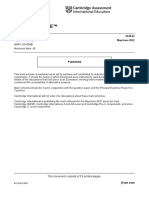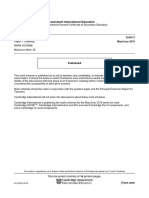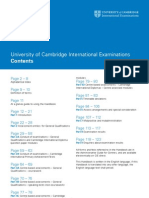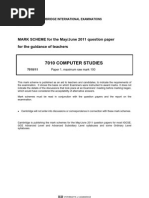Cambridge IGCSE™: Mandarin Chinese 0547/11 May/June 2020
Cambridge IGCSE™: Mandarin Chinese 0547/11 May/June 2020
Uploaded by
OCopyright:
Available Formats
Cambridge IGCSE™: Mandarin Chinese 0547/11 May/June 2020
Cambridge IGCSE™: Mandarin Chinese 0547/11 May/June 2020
Uploaded by
OOriginal Title
Copyright
Available Formats
Share this document
Did you find this document useful?
Is this content inappropriate?
Copyright:
Available Formats
Cambridge IGCSE™: Mandarin Chinese 0547/11 May/June 2020
Cambridge IGCSE™: Mandarin Chinese 0547/11 May/June 2020
Uploaded by
OCopyright:
Available Formats
Cambridge IGCSE™
MANDARIN CHINESE 0547/11
Paper 1 Listening May/June 2020
MARK SCHEME
Maximum Mark: 30
Published
Students did not sit exam papers in the June 2020 series due to the Covid-19 global pandemic.
This mark scheme is published to support teachers and students and should be read together with the
question paper. It shows the requirements of the exam. The answer column of the mark scheme shows the
proposed basis on which Examiners would award marks for this exam. Where appropriate, this column also
provides the most likely acceptable alternative responses expected from students. Examiners usually review
the mark scheme after they have seen student responses and update the mark scheme if appropriate. In the
June series, Examiners were unable to consider the acceptability of alternative responses, as there were no
student responses to consider.
Mark schemes should usually be read together with the Principal Examiner Report for Teachers. However,
because students did not sit exam papers, there is no Principal Examiner Report for Teachers for the June
2020 series.
Cambridge International will not enter into discussions about these mark schemes.
Cambridge International is publishing the mark schemes for the June 2020 series for most Cambridge
IGCSE™ and Cambridge International A & AS Level components, and some Cambridge O Level
components.
This document consists of 10 printed pages.
© UCLES 2020 [Turn over
0547/11 Cambridge IGCSE – Mark Scheme May/June 2020
PUBLISHED
Generic Marking Principles
These general marking principles must be applied by all examiners when marking candidate answers. They should be applied alongside the
specific content of the mark scheme or generic level descriptors for a question. Each question paper and mark scheme will also comply with these
marking principles.
GENERIC MARKING PRINCIPLE 1:
Marks must be awarded in line with:
• the specific content of the mark scheme or the generic level descriptors for the question
• the specific skills defined in the mark scheme or in the generic level descriptors for the question
• the standard of response required by a candidate as exemplified by the standardisation scripts.
GENERIC MARKING PRINCIPLE 2:
Marks awarded are always whole marks (not half marks, or other fractions).
GENERIC MARKING PRINCIPLE 3:
Marks must be awarded positively:
• marks are awarded for correct/valid answers, as defined in the mark scheme. However, credit is given for valid answers which go beyond
the scope of the syllabus and mark scheme, referring to your Team Leader as appropriate
• marks are awarded when candidates clearly demonstrate what they know and can do
• marks are not deducted for errors
• marks are not deducted for omissions
• answers should only be judged on the quality of spelling, punctuation and grammar when these features are specifically assessed by the
question as indicated by the mark scheme. The meaning, however, should be unambiguous.
GENERIC MARKING PRINCIPLE 4:
Rules must be applied consistently e.g. in situations where candidates have not followed instructions or in the application of generic level
descriptors.
© UCLES 2020 Page 2 of 10
0547/11 Cambridge IGCSE – Mark Scheme May/June 2020
PUBLISHED
GENERIC MARKING PRINCIPLE 5:
Marks should be awarded using the full range of marks defined in the mark scheme for the question (however; the use of the full mark range
may be limited according to the quality of the candidate responses seen).
GENERIC MARKING PRINCIPLE 6:
Marks awarded are based solely on the requirements as defined in the mark scheme. Marks should not be awarded with grade thresholds or
grade descriptors in mind.
© UCLES 2020 Page 3 of 10
0547/11 Cambridge IGCSE – Mark Scheme May/June 2020
PUBLISHED
2 General Marking Principles
2.1 It is not possible to list all acceptable alternatives in the Detailed Mark Scheme provided in Section 3. You will need to consider all
alternative answers and unexpected approaches in candidates’ scripts, make a decision on whether they communicate the required
elements, in consultation with your Team Leader if necessary (or with your Product Manager if you are a single Examiner), and
award marks accordingly.
The following marking principles underpin the detailed instructions provided in Section 5 of the Mark Scheme. Where a decision is taken to
deviate from these principles for a particular question, this will be specified in the Mark Scheme. Often the general principles will have
to be weighed up against each other, e.g. the answer might pass the look-alike test (2.5(b)), but if the candidate has produced an answer that
is another word in the target language they will not score (2.6).
2.2 Crossing out:
(a) If a candidate changes his/her mind over an answer and crosses out an attempt, award a mark if the final attempt is correct.
(b) If a candidate crosses out an answer to a whole question but makes no second attempt at it, mark the crossed out work.
2.3 More than the stipulated number of boxes ticked/crossed by the candidate:
(a) If more than one attempt is visible, but the candidate has clearly indicated which attempt is his/her final answer (e.g. by crossing out
other attempts or by annotating the script in some way), mark in the usual way.
(b) If two attempts are visible (e.g. 2 boxes ticked instead of the 1 box stipulated), and neither has been crossed out/discounted by the
candidate, no mark can be awarded.
(c) Where candidates must tick a number of boxes (e.g. tick the 5 true statements) and tick too many, apply the following rule: deduct the
number of ‘extra’ answers indicated by the candidate from their number of correct answers. The remaining number is the mark
awarded, e.g. the candidate is asked to tick 5 statements, but ticks 7. 5 of the ticks are correctly placed, but 2 are ‘extras’ (7 ticks
placed by candidate minus 5 ticks required by rubric = 2 ‘extras’). Therefore the candidate is awarded a mark of 3.
(d) Answers in pen do not take precedence over answers in pencil, e.g. if a candidate is asked to tick 1 box and ticks 2, one in pen and the
other in pencil, the mark cannot be awarded unless there is explicit indication from the candidate as to which is his/her final answer.
© UCLES 2020 Page 4 of 10
0547/11 Cambridge IGCSE – Mark Scheme May/June 2020
PUBLISHED
2.4 For questions requiring more than one element for the answer, (i) and (ii), where the answers are interchangeable:
(a) Both correct answers on line 1 and line 2 blank = 2
(b) Both correct answers on line 1 and line 2 wrong = 1
(or vice-versa)
2.5 Answers requiring the use of French (rather than a non-verbal response) should be marked for communication. Tolerate inaccuracies provided
the message is clear.
(a) ‘If in doubt, sound it out’: if you read what the candidate has written, does it sound like the correct answer?
(b) Look-alike test: does what the candidate has written look like the correct answer?
(c) Accept incorrect gender or person unless Mark Scheme specifies otherwise.
(d) Accept incorrect possessive adjectives, unless Mark Scheme specifies otherwise.
2.6 Unless the Mark Scheme specifies otherwise, do not accept incorrect Chinese if the word given means something else in Chinese.
(Incorrect Chinses which constitutes a word in any language other than Chinese is marked (i) on the basis of whether it is accepted or refused
in the Mark Scheme and (ii) if not mentioned in the Mark Scheme, on the basis of 4.5 above).
2.7 Annotation used in the Mark Scheme:
(a) INV = invalidation and is used when additional material included by the candidate is judged to invalidate an otherwise correct answer
thus preventing him/her from scoring the mark (INV = 0).
(b) tc = ‘tout court’ and means that on its own the material is not sufficient to score the mark.
(c) HA = harmless additional material which in conjunction with the correct answer does not prevent the candidate from scoring the mark.
(d) BOD = benefit of the doubt and is used to indicate material considered by the Examiner and judged to be more correct than incorrect:
the benefit of the doubt is given to the candidate and the mark is awarded.
© UCLES 2020 Page 5 of 10
0547/11 Cambridge IGCSE – Mark Scheme May/June 2020
PUBLISHED
2.8 No response and '0' marks
There is a NR (No Response) option in RM Assessor.
Award NR (No Response):
If there is nothing written at all in the answer space or
If there is only a comment which does not in any way relate to the question being asked (e.g. ‘can’t do’ or ‘don’t know’) or
If there is only a mark which isn’t an attempt at the question (e.g. a dash, a question mark).
Award 0:
If there is any attempt that earns no credit. This could, for example, include the candidate copying all or some of the question, or any working
that does not earn any marks, whether crossed out or not.
© UCLES 2020 Page 6 of 10
0547/11 Cambridge IGCSE – Mark Scheme May/June 2020
PUBLISHED
2.9 Extra material:
It is the candidate’s responsibility to answer questions in such a way as to demonstrate to the Examiner that s/he has understood the
recorded material. Where candidates introduce extra, irrelevant material to an otherwise correct answer the danger is that the Examiner is
being forced to ‘choose’ the correct answer and s/he cannot be certain that the candidate has shown understanding. Where the Examiner is
put in this position the mark cannot be awarded. The Detailed Mark Scheme cannot cover all eventualities and where specific instructions are
not provided, Examiners must check the transcript to ensure the correct elements which would qualify for the mark are not contradicted or
distorted by any extra material. The following, general, rules should be applied:
(a) Extra material, mentioned in the this is acceptable and is not penalised
Mark Scheme, which reinforces
the correct answer or in itself
constitutes an alternative correct
answer:
(b) Extra material which constitutes the Examiner needs to decide, by consulting the transcript and the Team Leader if necessary,
an alternative answer, but whether the alternative answer constitutes:
which is not explicitly (i) an alternative correct answer, in which case this falls into category (a) and the answer should
mentioned in the Mark be rewarded
Scheme: (ii) or an answer which on its own would be refused, in which case this falls into category (c) and
the answer should be refused
(c) Extra material which constitutes this puts the Examiner in the position of having to ‘choose’ which is the candidate’s ‘final’ answer
an alternative answer – the Examiner cannot be sure what the candidate has understood – and the mark cannot be
specifically refused in the awarded
Mark Scheme:
(d) Extra material which distorts or this affects communication – the Examiner cannot be sure what the candidate has understood –
contradicts the correct answer: and the mark cannot be awarded
(e) Extra material introduced by the this affects communication – the Examiner cannot be sure what the candidate has understood –
candidate and which does not and the mark cannot be awarded. It can sometimes be difficult to draw the line between what is a
feature in the original transcript: deduction made by an able candidate on the basis of what they have heard and pure guesswork.
Therefore where a particular answer is not covered in the Mark Scheme, Examiners should
consult their Team Leader
© UCLES 2020 Page 7 of 10
0547/11 Cambridge IGCSE – Mark Scheme May/June 2020
PUBLISHED
3 Detailed Mark Scheme
Section 1 Exercise 1
Question Answer Marks
1 B 1
2 A 1
3 A 1
4 B 1
5 C 1
Section 1 Exercise 2
Question Answer Marks
6 C 1
7 A 1
8 C 1
9 A 1
10 B 1
© UCLES 2020 Page 8 of 10
0547/11 Cambridge IGCSE – Mark Scheme May/June 2020
PUBLISHED
Section 2 Exercise 1
Question Answer Marks
11 D 1
12 C 1
13 B 1
14 A 1
15 G 1
Section 2 Exercise 2
Question Answer Marks
16 Type in the letter for each correct option: 5
B
D
E
F
H
© UCLES 2020 Page 9 of 10
0547/11 Cambridge IGCSE – Mark Scheme May/June 2020
PUBLISHED
Section 3 Exercise 1
Question Answer Marks
17 D 1
18 B 1
19 G 1
20 F 1
21 E 1
Section 3 Exercise 2
Question Answer Marks
22 奶奶 1
23 七岁 1
24(i) 豆腐 1
24(ii) 包子 1
25 开餐厅 1
NB For questions with 2 interchangeable answers: 2 correct answers on line 1, line 2 blank = 2; 2 correct answers on line 1, line 2 wrong
= 1 (or vice versa)
TICK BLANK PAGES
© UCLES 2020 Page 10 of 10
You might also like
- Cambridge Igcse Mandarin As A Foreign Language WorkbookDocument27 pagesCambridge Igcse Mandarin As A Foreign Language WorkbookO75% (4)
- NUST 2024 Undergraduate IntakeDocument6 pagesNUST 2024 Undergraduate Intakenomoszeng100% (4)
- Cambridge IGCSE™: French 0520/22 May/June 2020Document13 pagesCambridge IGCSE™: French 0520/22 May/June 2020wogim74052No ratings yet
- Cambridge IGCSE™: French 0520/23 May/June 2020Document13 pagesCambridge IGCSE™: French 0520/23 May/June 2020wogim74052No ratings yet
- November 2020 Mark Scheme Paper 13Document14 pagesNovember 2020 Mark Scheme Paper 13Andreea PopescuNo ratings yet
- Cambridge IGCSE™: French 0520/22 March 2020Document13 pagesCambridge IGCSE™: French 0520/22 March 2020Nipun JhalaniNo ratings yet
- Cambridge IGCSE™: French 0520/11 May/June 2020Document11 pagesCambridge IGCSE™: French 0520/11 May/June 2020janmarkowski23No ratings yet
- Cambridge IGCSE™: French 0520/12 May/June 2020Document11 pagesCambridge IGCSE™: French 0520/12 May/June 2020HemaNo ratings yet
- Cambridge IGCSE™: French 0520/12 March 2020Document14 pagesCambridge IGCSE™: French 0520/12 March 2020Nipun JhalaniNo ratings yet
- Cambridge IGCSE™ (9-1) : French 7156/22 October/November 2020Document14 pagesCambridge IGCSE™ (9-1) : French 7156/22 October/November 2020MonaNo ratings yet
- J21 Paper 22 AnsDocument12 pagesJ21 Paper 22 Ansmya hayleyNo ratings yet
- Cambridge Assessment International Education: French 0520/22 May/June 2019Document13 pagesCambridge Assessment International Education: French 0520/22 May/June 2019Prabhat DwivediNo ratings yet
- Cambridge Assessment International Education: Malay 0546/22 May/June 2019Document13 pagesCambridge Assessment International Education: Malay 0546/22 May/June 2019Eve KamNo ratings yet
- June 2021 Mark Scheme 11Document10 pagesJune 2021 Mark Scheme 11Carrisa WNo ratings yet
- Cambridge Assessment International Education: French 0520/22 March 2019Document13 pagesCambridge Assessment International Education: French 0520/22 March 2019AlyaaNo ratings yet
- 0520_s22_ms_23Document8 pages0520_s22_ms_23FantasticMeerNo ratings yet
- Cambridge IGCSE™: Malay 0546/22 May/June 2022Document10 pagesCambridge IGCSE™: Malay 0546/22 May/June 2022nora dilaNo ratings yet
- 646828-june-2021-mark-scheme-paper-02Document13 pages646828-june-2021-mark-scheme-paper-02randima adikariNo ratings yet
- Cambridge Assessment International Education: French 0520/12 March 2019Document14 pagesCambridge Assessment International Education: French 0520/12 March 2019Andrew David LlewellynNo ratings yet
- Cambridge Assessment International Education: French 0520/22 May/June 2018Document13 pagesCambridge Assessment International Education: French 0520/22 May/June 2018Prabhat DwivediNo ratings yet
- Cambridge Assessment International Education: French 0520/21 October/November 2019Document13 pagesCambridge Assessment International Education: French 0520/21 October/November 2019PARIS SHREE GUPTANo ratings yet
- 0520_s19_ms_12Document14 pages0520_s19_ms_12mulisuarez7No ratings yet
- Cambridge IGCSE™: Foreign Language Spanish 0530/22 February/March 2022Document10 pagesCambridge IGCSE™: Foreign Language Spanish 0530/22 February/March 2022Prisha DangNo ratings yet
- Cambridge Assessment International Education: Malay 0546/23 May/June 2019Document13 pagesCambridge Assessment International Education: Malay 0546/23 May/June 2019ezeeshah0512No ratings yet
- Cambridge Assessment International Education: German 0525/21 May/June 2018Document14 pagesCambridge Assessment International Education: German 0525/21 May/June 2018Andrew David LlewellynNo ratings yet
- Cambridge Assessment International Education: German 0525/22 May/June 2018Document15 pagesCambridge Assessment International Education: German 0525/22 May/June 2018Andrew David LlewellynNo ratings yet
- Cambridge Assessment International Education: German 0525/12 May/June 2018Document13 pagesCambridge Assessment International Education: German 0525/12 May/June 2018Andrew David LlewellynNo ratings yet
- Cambridge IGCSE™: Spanish 0530/22 May/June 2022Document11 pagesCambridge IGCSE™: Spanish 0530/22 May/June 2022ParvNo ratings yet
- Igcse MalayDocument12 pagesIgcse MalaynoorenNo ratings yet
- 0520_s19_ms_13Document14 pages0520_s19_ms_13mulisuarez7No ratings yet
- Cambridge IGCSE™: French 0520/22Document8 pagesCambridge IGCSE™: French 0520/22John MutarauswaNo ratings yet
- Cambridge Assessment International Education: Malay 0546/22 May/June 2018Document14 pagesCambridge Assessment International Education: Malay 0546/22 May/June 2018Eve KamNo ratings yet
- Cambridge IGCSE™: German 0525/41 May/June 2020Document31 pagesCambridge IGCSE™: German 0525/41 May/June 2020kalman.valkovszkyNo ratings yet
- June 2019 Mark Scheme 11Document14 pagesJune 2019 Mark Scheme 11mabrouk jariNo ratings yet
- 9702_s20_ms_42Document17 pages9702_s20_ms_42sijepereraNo ratings yet
- Cambridge IGCSE™: French 0520/22 October/November 2020Document14 pagesCambridge IGCSE™: French 0520/22 October/November 2020Prabhat DwivediNo ratings yet
- 7164_s24_ms_22Document10 pages7164_s24_ms_22rokiwix621No ratings yet
- Cambridge IGCSE™: French 0520/22 May/June 2021Document8 pagesCambridge IGCSE™: French 0520/22 May/June 2021vridhi bhanushali100% (1)
- 0520 - s23 - Ms - 21 (1) FrenchDocument10 pages0520 - s23 - Ms - 21 (1) Frenchherogada06No ratings yet
- Cambridge Assessment International Education: Spanish 0530/12 May/June 2018Document17 pagesCambridge Assessment International Education: Spanish 0530/12 May/June 2018emmyNo ratings yet
- Cambridge International AS & A Level: Physics 9702/22 May/June 2020Document14 pagesCambridge International AS & A Level: Physics 9702/22 May/June 2020Kamran KhanNo ratings yet
- Cambridge Assessment International Education: French 0520/12 October/November 2019Document14 pagesCambridge Assessment International Education: French 0520/12 October/November 2019andy-cai2005No ratings yet
- Cambridge IGCSE™: French 0520/22 February/March 2022Document8 pagesCambridge IGCSE™: French 0520/22 February/March 2022Aahana SinghalNo ratings yet
- Cambridge Assessment International Education: German 0525/11 May/June 2018Document13 pagesCambridge Assessment International Education: German 0525/11 May/June 2018Andrew David LlewellynNo ratings yet
- Cambridge IGCSE™: Spanish 0530/21Document11 pagesCambridge IGCSE™: Spanish 0530/21komalds88No ratings yet
- Cambridge International AS & A Level: Physics 9702/22 May/June 2020Document14 pagesCambridge International AS & A Level: Physics 9702/22 May/June 2020junk filesNo ratings yet
- Cambridge International AS & A Level: Physics 9702/41 May/June 2020Document19 pagesCambridge International AS & A Level: Physics 9702/41 May/June 2020Mahi ChowdhuryNo ratings yet
- Cambridge IGCSE™: Mandarin Chinese 0547/22Document10 pagesCambridge IGCSE™: Mandarin Chinese 0547/22John AyubNo ratings yet
- Cambridge International AS & A Level: Physics 9702/42 May/June 2020Document17 pagesCambridge International AS & A Level: Physics 9702/42 May/June 2020Tino KambaniNo ratings yet
- Reading-0546 s23 Ms 22gggDocument11 pagesReading-0546 s23 Ms 22gggMohamedNo ratings yet
- Cambridge International AS & A Level: Physics 9702/52 May/June 2020Document11 pagesCambridge International AS & A Level: Physics 9702/52 May/June 2020Muhammad RidzwanNo ratings yet
- Cambridge International AS & A Level: Physics 9702/23 May/June 2020Document14 pagesCambridge International AS & A Level: Physics 9702/23 May/June 2020junk filesNo ratings yet
- Cambridge IGCSE™: French 0520/23Document8 pagesCambridge IGCSE™: French 0520/23Christiaan Marais BoshoffNo ratings yet
- Cambridge IGCSE™: French 0520/21Document10 pagesCambridge IGCSE™: French 0520/21Madalitso PhiriNo ratings yet
- Cambridge Assessment International Education: French 0520/13 October/November 2019Document14 pagesCambridge Assessment International Education: French 0520/13 October/November 2019andy-cai2005No ratings yet
- Cambridge IGCSE™: French 0520/22Document8 pagesCambridge IGCSE™: French 0520/22Anshita RajeshNo ratings yet
- Cambridge IGCSE™: German 0525/21Document12 pagesCambridge IGCSE™: German 0525/21Hayden YeungNo ratings yet
- 0520_s24_ms_23Document8 pages0520_s24_ms_23savyam.batra.batra.1No ratings yet
- Cambridge International AS & A Level: Physics 9702/41 May/June 2020Document19 pagesCambridge International AS & A Level: Physics 9702/41 May/June 2020Tino KambaniNo ratings yet
- Cambridge International AS & A Level: Biology 9700/52 May/June 2020Document9 pagesCambridge International AS & A Level: Biology 9700/52 May/June 2020saliwe.muzavaziNo ratings yet
- Cambridge Assessment International Education: French 0520/11 October/November 2018Document14 pagesCambridge Assessment International Education: French 0520/11 October/November 2018vridhi bhanushaliNo ratings yet
- Cambridge IGCSE: Mandarin Chinese 0547/13Document12 pagesCambridge IGCSE: Mandarin Chinese 0547/13ONo ratings yet
- Cambridge IGCSE: Mandarin Chinese 0547/11Document12 pagesCambridge IGCSE: Mandarin Chinese 0547/11ONo ratings yet
- Ib Choices Advice - FisDocument5 pagesIb Choices Advice - FisONo ratings yet
- Cambridge International Examinations: Economics 9708/11 May/June 2017Document3 pagesCambridge International Examinations: Economics 9708/11 May/June 2017Ahmed HishamNo ratings yet
- Cambridge Assessment International Education: Commerce 7100/12 May/June 2018Document3 pagesCambridge Assessment International Education: Commerce 7100/12 May/June 2018Zera 1402No ratings yet
- Cambridge IGCSE™: Cambridge International Mathematics 0607/61 May/June 2021Document7 pagesCambridge IGCSE™: Cambridge International Mathematics 0607/61 May/June 2021萧志No ratings yet
- 5126 w09 Ms 4Document5 pages5126 w09 Ms 4mstudy123456No ratings yet
- Has Guidebook LastDocument56 pagesHas Guidebook Lastgeorgesways247No ratings yet
- Cambridge International Examinations: English Language 1123/21 May/June 2017Document16 pagesCambridge International Examinations: English Language 1123/21 May/June 2017ruzain50% (2)
- 0500 First Language English: MARK SCHEME For The May/June 2014 SeriesDocument9 pages0500 First Language English: MARK SCHEME For The May/June 2014 SeriesShen Yee TangNo ratings yet
- Prof Ed 1teaching Profession 1Document39 pagesProf Ed 1teaching Profession 1Cielo Nicole De GuzmanNo ratings yet
- Cambridge IGCSE ™: Co-Ordinated Sciences 0654/21 October/November 2022Document3 pagesCambridge IGCSE ™: Co-Ordinated Sciences 0654/21 October/November 2022wangfeifei620No ratings yet
- 7115 Y12 SyDocument32 pages7115 Y12 SymrsundeepsNo ratings yet
- Icta Rules and Regulations DraftDocument25 pagesIcta Rules and Regulations DraftchandyNo ratings yet
- Anglo-Chinese School (Independent) Year 1 Exp Booklist For Year 2011Document10 pagesAnglo-Chinese School (Independent) Year 1 Exp Booklist For Year 2011sean_lim_35No ratings yet
- 2059 Pakistan Studies: MARK SCHEME For The May/June 2007 Question PaperDocument11 pages2059 Pakistan Studies: MARK SCHEME For The May/June 2007 Question PaperAnnaNo ratings yet
- Cambridge Assessment International Education: Biology 0610/33 October/November 2017Document11 pagesCambridge Assessment International Education: Biology 0610/33 October/November 2017123 456No ratings yet
- Destination Pakistan - Using Your Cambridge Qualifications To Study in PakistanDocument18 pagesDestination Pakistan - Using Your Cambridge Qualifications To Study in PakistanAADIKHANNo ratings yet
- Cambridge Assessment International Education: Arabic 3180/02 October/November 2018Document14 pagesCambridge Assessment International Education: Arabic 3180/02 October/November 2018shabibibrahim808No ratings yet
- Pla Scholarship Application Form 2006Document6 pagesPla Scholarship Application Form 2006sazzyboyyNo ratings yet
- Cambridge O Level: Additional Mathematics 4037/12 October/November 2020Document9 pagesCambridge O Level: Additional Mathematics 4037/12 October/November 2020Sanish NoderchandNo ratings yet
- Cambridge IGCSE ™Document7 pagesCambridge IGCSE ™grengtaNo ratings yet
- Cambridge International Examinations: Chemistry 9701/12 May/June 2017Document3 pagesCambridge International Examinations: Chemistry 9701/12 May/June 2017qpalzmNo ratings yet
- CIE 2010 Handbook For Centres - IGCSE - O-Levels - A-LevelsDocument124 pagesCIE 2010 Handbook For Centres - IGCSE - O-Levels - A-Levelssafwan120% (1)
- Zone 2 Final Cambridge IGCSE GCE November 2011 TimetableDocument20 pagesZone 2 Final Cambridge IGCSE GCE November 2011 TimetableHassaan KhanNo ratings yet
- 7010 Computer Studies: MARK SCHEME For The May/June 2011 Question Paper For The Guidance of TeachersDocument12 pages7010 Computer Studies: MARK SCHEME For The May/June 2011 Question Paper For The Guidance of TeachersJazzNo ratings yet
- 9702 w10 Ms 53Document4 pages9702 w10 Ms 53Munir AslamNo ratings yet
- 4024 s20 Ms 11 PDFDocument7 pages4024 s20 Ms 11 PDFAvinash DilipNo ratings yet
- ER 2020 - MFA - PoliteknikDocument23 pagesER 2020 - MFA - PoliteknikFuad HasyimNo ratings yet
- Cambridge IGCSE™: Mathematics 0580/21 May/June 2020Document7 pagesCambridge IGCSE™: Mathematics 0580/21 May/June 2020Luis HuangNo ratings yet
- Ilovepdf MergedDocument16 pagesIlovepdf MergedLet's hit 100k sub without any videosNo ratings yet
- November 2020 (v2) MS - Paper 2 CIE Chemistry GCSEDocument3 pagesNovember 2020 (v2) MS - Paper 2 CIE Chemistry GCSEanayNo ratings yet





























































































